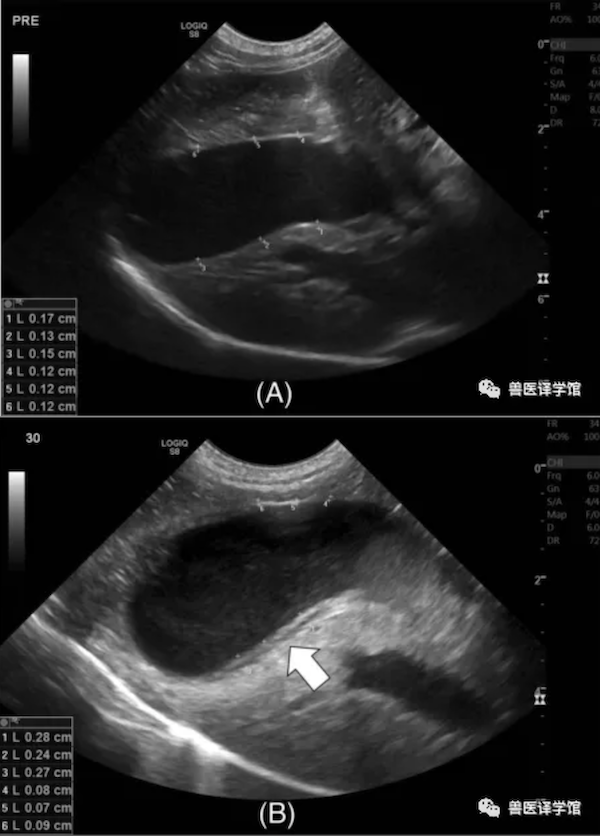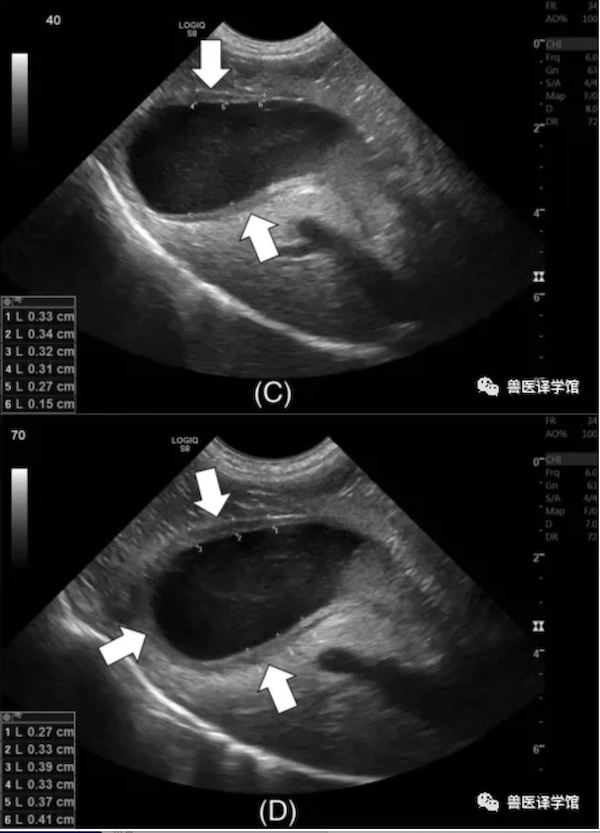
背 景
右美托咪啶常用于腹部超声检查前或检查期间的镇静。右旋美托咪啶对胆囊壁厚度的影响尚不清楚。
目 的
探讨右旋美托咪啶应用与犬胆囊壁增厚的关系。假说是右旋美托咪啶镇静会导致一过性胆囊壁增厚。胆囊壁厚度与镇静时间和卧位有关。
动 物
79只客户养的狗和10只健康的研究犬。
方 法
采用前瞻性观察研究(n=79),观察右旋美托咪啶镇静后胆囊壁增厚(>2.0 mm)的发生率。采用随机、交叉研究(n=10)评价时间和卧位对胆囊壁增厚的影响。采用线性混合模型。
结 果
右美托咪啶中位剂量为5.0μg/kg(范围2.0~12.5μg/kg),患犬胆囊壁增厚的比例为24.05%(19/79;95%可信区间为15.1%~35.0%)。镇静后,研究犬左侧(5/10,50%;95%CI,18.7%~81.3%)和背侧(7/10,70%;95%CI,34.8%~93.3%)胆囊壁增厚的比例无显著差异(P=0.45)。胆囊壁在20-40分钟内开始增厚。镇静时间与胆囊壁增厚显著相关(P<0.001)。5只狗在侧卧(5)和背卧(4)时出现9例腹膜积液。


结 论
右旋美托咪啶镇静与胆囊壁增厚(>2.0 mm)和腹水有关,这可能与病理病因相混淆。
个人经验与感想
1.在动物出现胆囊炎、肝病、胰腺炎、肝胆肿瘤、胆道梗阻、门脉高压、右心衰(包括心包积液)、低蛋白血症、化疗药物、肾功能衰竭,以及最近的过敏反应、输血、免疫介导性溶血性贫血、败血症、全身炎症反应综合征和弥散性血管内凝血。临床中最常见的低蛋白血症及过敏反应。
2.腹部扫查时,常常使用丙泊酚进行镇静扫查,丙泊酚会导致胃张力降低,胃食道括约肌压力降低,轻度降到肠道运动的振幅和节律。而右美进行镇静时,对肠道的蠕动影响决定于药物的剂量。右美托咪定对肠道蠕动的影响还存在争议。右美可以通过激活α2受体,迷走神经刺激引起的胃肠运动及肠道碳酸氢根的分泌受到抑制,从而抑制肠道蠕动。但是右美托咪定可以增强回肠的自发节律运动的振幅而不改变其节律,从而对肠道有正向作用。故右美托咪定对肠道的影响是不确定的。
3.胆囊壁增厚较少见,此处还想分享下头孢曲松钠对胆囊影像的影响—假胆囊结石。头孢曲松钠在血液中与白蛋白结合,45%不经生物转化以原形随胆汁排泄。头孢曲松钠可以与钙离子形成沉淀物,逐渐形成“假结石”。一般情况下,扫查到胆结石时,需询问动物的病史及用药史,一般情况下停药后结石会自动消失。
Sedation with dexmedetomidine is associated with transientgallbladder wall thickening and peritoneal effusion in somedogs undergoing abdominal ultrasonographyBackground:Dexmedetomidine often is used for sedation before or during abdominal ultrasonography. The effect of dexmedetomidine on gallbladder wall thickness isunknown.Hypothesis/Objectives:To investigate the relationship between dexmedetomidineadministration and gallbladder wall thickening in dogs. The hypothesis was that sedation with dexmedetomidine will cause transient gallbladder wall thickening. Gallbladder wall thickness will be associated with duration of sedation and recumbencyposition.Animals: Seventy-nine client owned dogs and 10 healthy research dogsMethods:A prospective observational study (n = 79) was used to establish the prevalence of gallbladder wall thickening (> 2.0 mm) after sedation withdexmedetomidine. A randomized, crossover study (n = 10) was used to evaluate theeffect of time and recumbency position on the development of gallbladder wall thickening. Linear mixed models were used.Results:The proportion of client-owned dogs that developed gallbladder wall thickening was 24.05% (19/79; 95% confidence interval [CI], 15.1%-35.0%) with a mediandose of dexmedetomidine of 5.0 μg/kg (range, 2.0-12.5 μg/kg). After sedation, theproportion of research dogs that developed gallbladder wall thickening in left lateral(5/10, 50%; 95% CI, 18.7%-81.3%) and dorsal (7/10, 70%; 95% CI, 34.8%-93.3%)recumbency did not differ significantly (P = .45). Gallbladder wall thickening developed within 20 to 40 minutes. Duration of sedation was significantly associated withthickening of the gallbladder wall (P < .001). Five dogs developed 9 instances of peritoneal effusion in both lateral (5) and dorsal (4) recumbency.Conclusions and Clinical Importance:Sedation with dexmedetomidine is associatedwith gallbladder wall thickening (> 2.0 mm) and peritoneal effusion that could be confused with pathologic etiologies.


